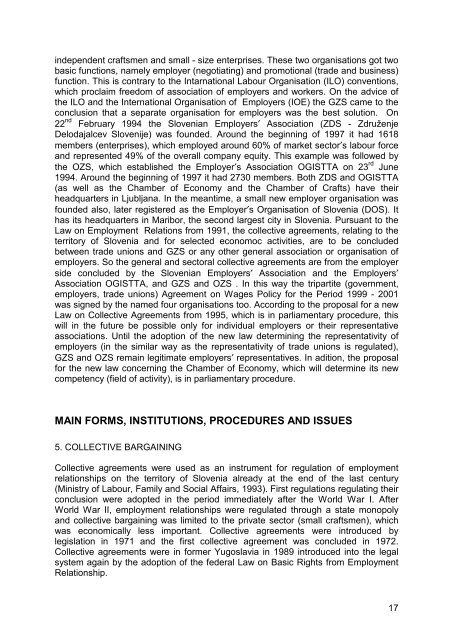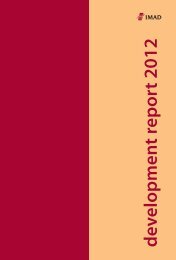The Development of New Industrial Relations in Slovenia - UMAR
The Development of New Industrial Relations in Slovenia - UMAR
The Development of New Industrial Relations in Slovenia - UMAR
Create successful ePaper yourself
Turn your PDF publications into a flip-book with our unique Google optimized e-Paper software.
<strong>in</strong>dependent craftsmen and small - size enterprises. <strong>The</strong>se two organisations got two<br />
basic functions, namely employer (negotiat<strong>in</strong>g) and promotional (trade and bus<strong>in</strong>ess)<br />
function. This is contrary to the Intarnational Labour Organisation (ILO) conventions,<br />
which proclaim freedom <strong>of</strong> association <strong>of</strong> employers and workers. On the advice <strong>of</strong><br />
the ILO and the International Organisation <strong>of</strong> Employers (IOE) the GZS came to the<br />
conclusion that a separate organisation for employers was the best solution. On<br />
22 nd February 1994 the <strong>Slovenia</strong>n Employers′ Association (ZDS - Združenje<br />
Delodajalcev Slovenije) was founded. Around the beg<strong>in</strong>n<strong>in</strong>g <strong>of</strong> 1997 it had 1618<br />
members (enterprises), which employed around 60% <strong>of</strong> market sector′s labour force<br />
and represented 49% <strong>of</strong> the overall company equity. This example was followed by<br />
the OZS, which established the Employer′s Association OGISTTA on 23 rd June<br />
1994. Around the beg<strong>in</strong>n<strong>in</strong>g <strong>of</strong> 1997 it had 2730 members. Both ZDS and OGISTTA<br />
(as well as the Chamber <strong>of</strong> Economy and the Chamber <strong>of</strong> Crafts) have their<br />
headquarters <strong>in</strong> Ljubljana. In the meantime, a small new employer organisation was<br />
founded also, later registered as the Employer′s Organisation <strong>of</strong> <strong>Slovenia</strong> (DOS). It<br />
has its headquarters <strong>in</strong> Maribor, the second largest city <strong>in</strong> <strong>Slovenia</strong>. Pursuant to the<br />
Law on Employment <strong>Relations</strong> from 1991, the collective agreements, relat<strong>in</strong>g to the<br />
territory <strong>of</strong> <strong>Slovenia</strong> and for selected economoc activities, are to be concluded<br />
between trade unions and GZS or any other general association or organisation <strong>of</strong><br />
employers. So the general and sectoral collective agreements are from the employer<br />
side concluded by the <strong>Slovenia</strong>n Employers′ Association and the Employers′<br />
Association OGISTTA, and GZS and OZS . In this way the tripartite (government,<br />
employers, trade unions) Agreement on Wages Policy for the Period 1999 - 2001<br />
was signed by the named four organisations too. Accord<strong>in</strong>g to the proposal for a new<br />
Law on Collective Agreements from 1995, which is <strong>in</strong> parliamentary procedure, this<br />
will <strong>in</strong> the future be possible only for <strong>in</strong>dividual employers or their representative<br />
associations. Until the adoption <strong>of</strong> the new law determ<strong>in</strong><strong>in</strong>g the representativity <strong>of</strong><br />
employers (<strong>in</strong> the similar way as the representativity <strong>of</strong> trade unions is regulated),<br />
GZS and OZS rema<strong>in</strong> legitimate employers′ representatives. In adition, the proposal<br />
for the new law concern<strong>in</strong>g the Chamber <strong>of</strong> Economy, which will determ<strong>in</strong>e its new<br />
competency (field <strong>of</strong> activity), is <strong>in</strong> parliamentary procedure.<br />
MAIN FORMS, INSTITUTIONS, PROCEDURES AND ISSUES<br />
5. COLLECTIVE BARGAINING<br />
Collective agreements were used as an <strong>in</strong>strument for regulation <strong>of</strong> employment<br />
relationships on the territory <strong>of</strong> <strong>Slovenia</strong> already at the end <strong>of</strong> the last century<br />
(M<strong>in</strong>istry <strong>of</strong> Labour, Family and Social Affairs, 1993). First regulations regulat<strong>in</strong>g their<br />
conclusion were adopted <strong>in</strong> the period immediately after the World War I. After<br />
World War II, employment relationships were regulated through a state monopoly<br />
and collective barga<strong>in</strong><strong>in</strong>g was limited to the private sector (small craftsmen), which<br />
was economically less important. Collective agreements were <strong>in</strong>troduced by<br />
legislation <strong>in</strong> 1971 and the first collective agreement was concluded <strong>in</strong> 1972.<br />
Collective agreements were <strong>in</strong> former Yugoslavia <strong>in</strong> 1989 <strong>in</strong>troduced <strong>in</strong>to the legal<br />
system aga<strong>in</strong> by the adoption <strong>of</strong> the federal Law on Basic Rights from Employment<br />
<strong>Relations</strong>hip.<br />
17
















